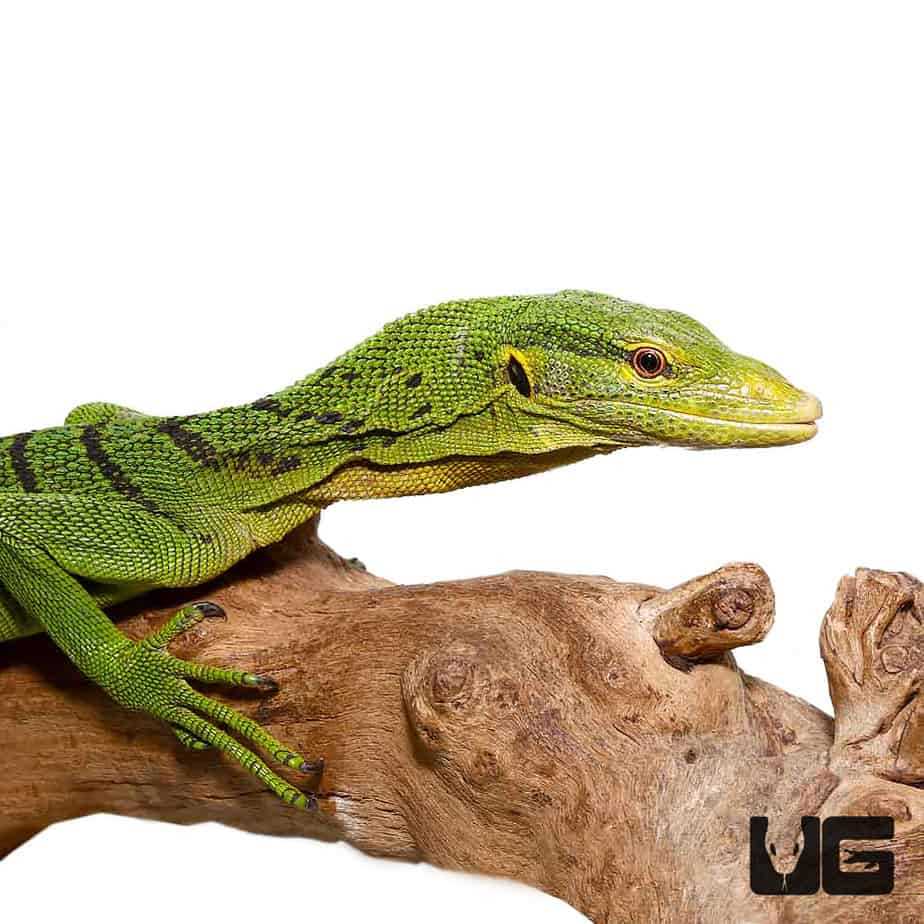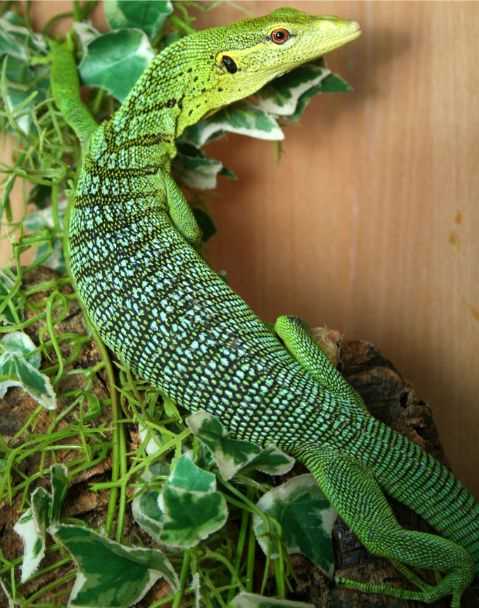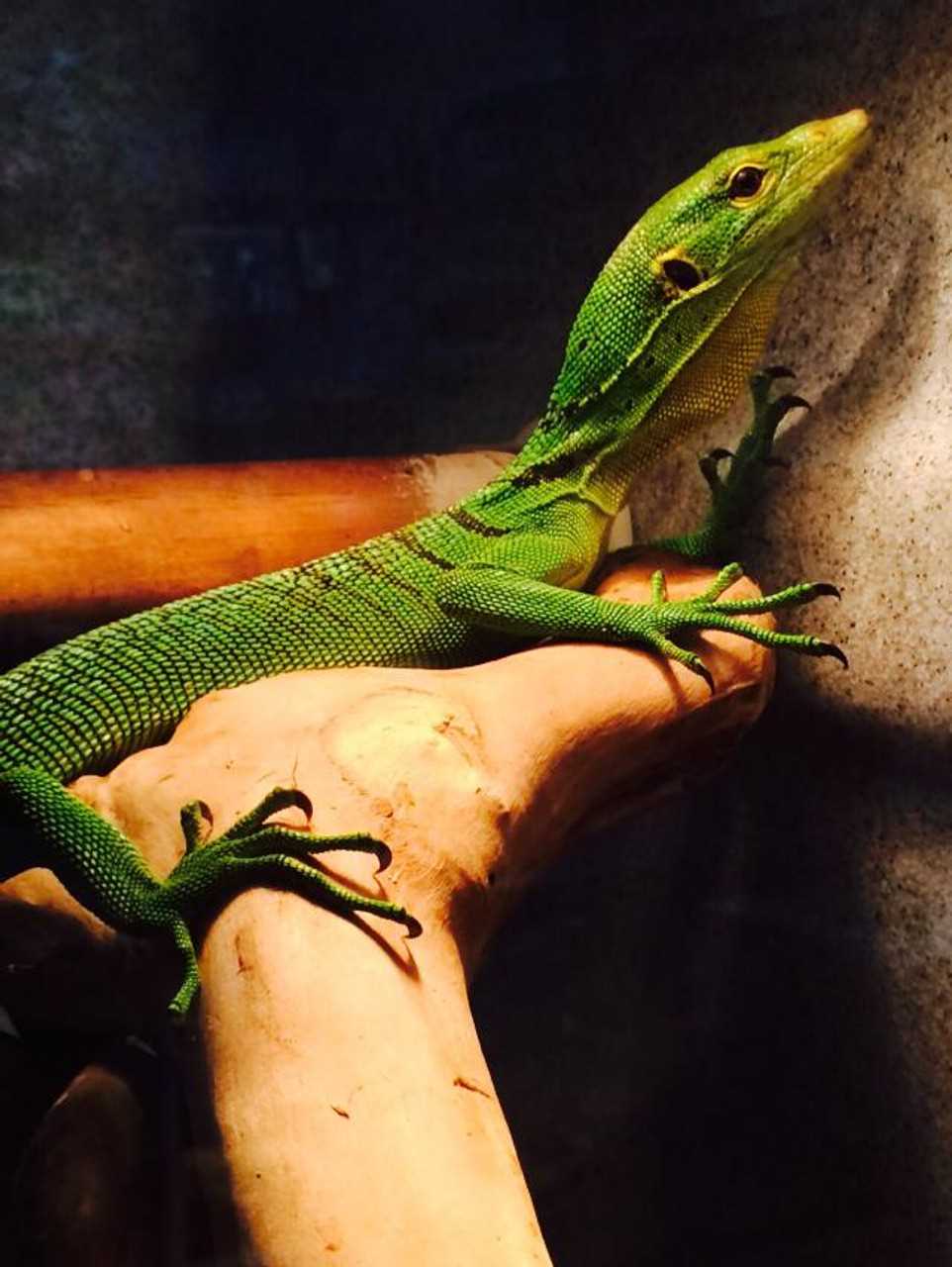
Native to the tropical rainforests of Southeast Asia, these arboreal reptiles have adapted to life in the treetops. With their keen senses and impressive athleticism, Green Tree Monitors are excellent climbers and can navigate the dense foliage of their natural habitat with ease. Their long, slender bodies and prehensile tails allow them to move gracefully through the branches.
What sets Green Tree Monitors apart is not just their physical appearance, but also their behavior. These reptiles are diurnal, meaning they are active during the day, unlike many other reptiles that are nocturnal. This makes them a fascinating species to observe, as you can witness their hunting and foraging habits in broad daylight.
Appearance and Physical Traits
Green tree monitors are a type of tropical lizard known for their vibrant green coloration. They have a sleek and slender body with long limbs, allowing them to move swiftly through the trees they inhabit. Green tree monitors have a large head, with a pointed snout and sharp teeth, which they use to catch their prey.
One of the distinguishing features of green tree monitors is their unique scales. Unlike other reptiles, their scales are keeled, meaning they have raised ridges running down the length of their body. These scales provide them with both protection and flexibility, allowing them to navigate through the dense foliage of their forest homes.
The vibrant green color of these reptiles serves as camouflage, helping them blend in with the leaves and branches of the trees they inhabit. This coloration also allows them to absorb sunlight more efficiently, aiding in thermoregulation.
In addition to their green coloration, green tree monitors may also have some variations in their patterns and markings. Some individuals may have speckles or stripes on their back, adding to their unique appearance.
Overall, the appearance of a green tree monitor is a perfect adaptation to its arboreal habitat. Its slender body, long limbs, and keeled scales make it an agile climber, and its vibrant green color provides excellent camouflage among the foliage.
Habitat and Distribution
The Green Tree Monitor’s natural habitat consists of dense vegetation and tall trees, where they can navigate using their sharp claws and prehensile tail. This tail helps them maintain balance while climbing and jumping from branch to branch. The monitors’ sleek body and long tail also make them excellent swimmers, allowing them to cross rivers and streams in search of food.
These reptiles have adapted to life in the trees, with specialized scales that enable them to cling to the smooth surfaces of branches and trunks. Their delicate, green-colored skin provides camouflage, allowing them to blend in with the foliage and avoid detection by predators.
The distribution of Green Tree Monitors is limited to specific regions of Southeast Asia. They can be found in Indonesia, particularly in the islands of Papua, Halmahera, and Misool. They are also present in parts of Papua New Guinea, including the islands of Manus and New Britain. Although their natural range is relatively small, these reptiles are well-suited to their habitat and play an important role in the tropical ecosystem.
Threats to Habitat and Conservation Status
Green Tree Monitors face several threats to their habitat and survival. The rapid deforestation occurring in the region is a major concern, as it leads to the destruction of their native rainforest habitats. The conversion of land for agriculture and logging operations significantly reduces the amount of suitable habitat available for these reptiles.
Additionally, the illegal pet trade poses a threat to Green Tree Monitors. These reptiles are highly prized for their beauty and unique characteristics, making them attractive to collectors. The capture and removal of individuals from their natural habitats can have a detrimental impact on their populations.
Due to these threats, Green Tree Monitors are classified as a vulnerable species by the International Union for Conservation of Nature (IUCN). Efforts are being made to protect their habitats and limit the impact of human activities on their population. Conservation initiatives focus on raising awareness, enforcing laws that prohibit poaching and illegal trade, and promoting sustainable land use practices in the region.
| Appearance and Physical Traits | Behavior and Lifestyle |
|---|---|
| Green Tree Monitors have a slender body and long tail | These reptiles are arboreal and spend most of their time in trees |
| They are solitary animals and tend to be territorial | |
| Their scales are adapted for gripping smooth surfaces | They are active during the day, often basking in the sun to regulate their body temperature |
| They have sharp claws for climbing and hunting | Green Tree Monitors are carnivorous, feeding on a variety of insects, small reptiles, and birds |
Keeping Green Tree Monitors as Pets
Due to their specific needs and habitat requirements, Green Tree Monitors are generally not recommended as pets for inexperienced reptile owners. They require a large enclosure that mimics their natural environment, with plenty of vertical space for climbing and basking. The enclosure should also be equipped with branches, vines, and hiding spots to meet the monito
Behavior and Lifestyle of Green Tree Monitors

Green tree monitors are fascinating reptiles native to the tropical rainforests of Indonesia and Papua New Guinea. They are a type of carnivorous lizard and belong to the family of monitors.
These green reptiles are well-adapted to life in the treetops. They have long, slender bodies and tails, which help them navigate through the dense canopy. Their coloration, which varies between shades of bright green and yellow, allows them to blend in with the lush foliage of the rainforest.
Green tree monitors are diurnal creatures, meaning they are most active during the day. They spend their time basking in the sun, foraging for food, and exploring their arboreal habitat. They are excellent climbers, thanks to their sharp claws and prehensile tails, which they use to grip branches and tree trunks.
While they are primarily solitary animals, green tree monitors can sometimes be found in small groups. They communicate with each other through vocalizations and visual displays, such as head bobbing and tail wagging.
These monitors are agile and quick, allowing them to catch their prey in the treetops. Their diet consists mainly of insects, spiders, small mammals, and birds. They use their keen eyesight and long tongues to locate and capture their food.
During the breeding season, male green tree monitors engage in territorial displays to attract females. Once a pair mates, the female will lay a clutch of eggs in a tree hollow or burrow. The eggs are then left unattended, and the female returns to her solitary lifestyle.
As tropical rainforests are facing increasing threats, including deforestation and habitat loss, the conservation status of green tree monitors is a concern. These beautiful reptiles are protected in many areas to ensure their survival in the wild.
Diet and Feeding Habits
Green tree monitors are carnivorous reptiles that primarily feed on a diet consisting of insects, small mammals, birds, and eggs. Being part of the monitor lizard family, they have sharp teeth and strong jaws that allow them to tear apart prey.
These monitors are opportunistic hunters, meaning they will consume whatever prey is available in their habitat. They are skilled climbers and use their long, agile bodies to navigate through the dense canopies of the rainforests.
Green tree monitors have a unique feeding behavior. They use their long, prehensile tails to grasp onto branches while using their long tongues to catch prey. This allows them to catch fast-moving insects and other small animals that inhabit their tropical rainforest habitat. Their sharp claws and excellent eyesight also aid them in hunting.
Overall, the diet and feeding habits of green tree monitors play a crucial role in maintaining their health and well-being. By providing them with a balanced and varied diet, we can ensure that these magnificent reptiles thrive both in the wild and in captivity.
Reproduction and Life Cycle
Green Tree Monitors are fascinating reptiles that belong to the family of Varanidae. These beautiful lizards have an intriguing life cycle and reproduction process.
Like other monitors, Green Tree Monitors are oviparous, which means they lay eggs to reproduce. The female monitors usually lay their eggs in tree hollows or in decaying logs found in their natural tropical rainforest habitat. They carefully choose a suitable nesting site to ensure the safety and protection of their offspring.
The female monitors typically lay a clutch of 4 to 10 eggs, although the number may vary depending on the individual. The eggs are soft-shelled and white, resembling small ping-pong balls. Once laid, the female covers them with leaves and vegetation to provide additional protection from predators and temperature fluctuations.
The incubation period for Green Tree Monitor eggs is approximately 200 to 240 days. This long incubation period is one of the reasons why these lizards are relatively rare in captivity. Temperature and humidity play crucial roles in the successful hatching of the eggs. The ideal temperature range for incubation is around 82 to 86 degrees Fahrenheit (28 to 30 degrees Celsius).
The life cycle of Green Tree Monitors is an intricate and fascinating process. These carnivorous reptiles play a crucial role in their tropical habitat and are a testament to the diverse and unique creatures that inhabit our planet.
Conservation Status and Threats
In addition to habitat loss, the illegal pet trade poses a significant threat to the survival of green tree monitors. These reptiles are highly desired in the exotic pet market for their vibrant green color, unique scales, and fascinating behavior. The demand for them as pets has resulted in the capture and removal of individuals from their natural habitats, often causing population declines.
Conservation Efforts

To combat these threats and conserve the green tree monitor, several conservation efforts are underway. The establishment of protected areas, such as national parks and reserves, helps to preserve the lizard’s natural habitat and provide safe spaces for their population to thrive.
Educational campaigns and awareness programs are also essential in educating local communities and the general public about the importance of conserving this reptile and its habitat. These initiatives aim to reduce the demand for green tree monitors as pets and promote sustainable practices that support the survival of the species in the long term.
Keeping Green Tree Monitors as Pets
Green Tree Monitors have unique physical traits that make them stand out. They have long, slender bodies covered in beautiful green scales, hence their name. These scales help them blend in with the foliage of the rainforest, providing them with effective camouflage.
Feeding
Handling and Interaction
Conclusion
Keeping Green Tree Monitors as pets can be a rewarding experience for experienced reptile enthusiasts who are willing to invest time and effort into their care. These stunning creatures require a specialized enclosure, a varied diet, and specific temperature and humidity levels. By providing them with the right conditions, you can enjoy observing their natural behaviors and beauty up close.

I’m Lena Adams—a product of an unconventional upbringing in the African wilderness. My father, a daring explorer of African wildlife, sparked my fascination with reptiles, a passion that intertwined with the tragic loss of my mother during an expedition, leaving an indelible mark on my life. Driven to understand the creatures that captivated my parents, I embarked on my journey, sharing insights about reptiles, frogs, and lizards on my website. Through my explorations and conservation efforts, I honour my family’s legacy while seeking connections—to the creatures, nature, and the mother whose presence I yearn to understand.
